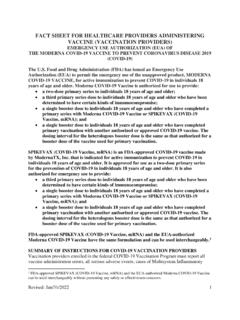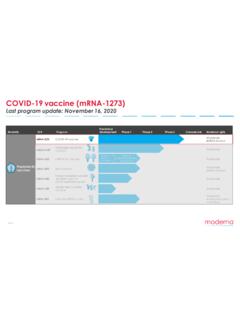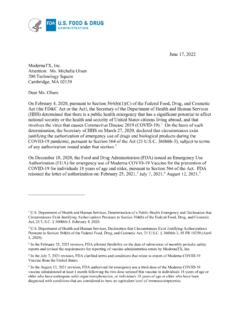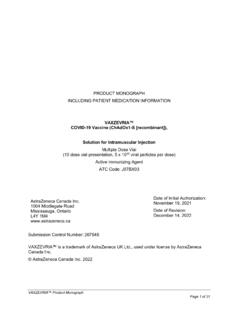Transcription of WHITE PAPER mRNA Vaccines - Moderna
1 WHITE PAPER . mRNA Vaccines : Disruptive Innovation in Vaccination May 2017. Corporate Headquarters | 320 Bent Street | Cambridge, MA 02141. p: f: WHITE PAPER . Moderna Therapeutics | May 2017. Evan Rachlin, MD. Michael Watson, MB ChB, MRCP, AFPM. INTRODUCTION. Vaccines to prevent infectious diseases are the greatest medical innovation of all time. The CDC estimates that childhood vaccinations given in the past two decades will prevent Americans from 322 million illnesses, 21 million hospitalizations, 732,000. deaths, $295 billion of direct costs, and $ trillion in social costs. For example, before the advent of the measles vaccine in 1963, the virus infected 500,000 Americans annually, causing 480,000 hospitalizations. Today, we see only 60 measles cases a year, primarily from foreign travelers. Smallpox, polio, diphtheria, pertussis, measles, mumps, and many other Vaccines have also had an enormous impact on public health.
2 (Figure 1). However, despite these remarkable successes, there is significant room for innovation in vaccine research, development, manu- facturing and delivery. EXISTING VACCINE PARADIGM. Immunization against disease has been practiced for a thousand years, from variolation (deliberately exposing a healthy person to small amounts of infected material) to vaccination in all of its forms today. The goal of vaccination is to safely pre-expose our immune system to a small, harmless dose of all or a piece of a pathogen (called an antigen) so that, if and/or when we encounter the actual pathogen in the future, our immune system is already prepared to fight it and prevent disease. Today we have Vaccines against more than 25 different diseases1, using at least half a dozen different approaches. These include weakened or killed versions of pathogens, inactivated toxins, partial subunits of the pathogen, and conjugates (combinations of strong and weak antigens).
3 All of these traditional approaches involve long, complex, and costly development and production. Traditional Vaccines face a number of challenges (Figure 2): 1. The target pathogens/antigens are grown in dedicated cell-culture and/or fermentation-based production before being extracted, killed, separated and purified. This involves a long, complex and costly process. 2. They often demonstrate efficacy empirically ( , without knowing why they work). The exact mechanism of protection may only be fully elucidated after the vaccine has been licensed and used and in some cases, such as pertussis (whooping cough), we still do not understand the mechanism of efficacy. 3. They require bespoke vaccine-specific production processes, production facilities and operators. Moreover, these capital investments must be made years in advance of vaccine approval, with all of the attendant risks that the vaccine could ultimately fail and waste this capital.
4 This, in turn, limits the vaccine targets that developers are able or willing to substainably pursue. 4. Existing Vaccines are only just learning to adjust the kind of immune response they induce, using adjuvants. NUCLEIC ACID Vaccines . Nucleic acid Vaccines , DNA and messenger RNA (mRNA), deliver the nucleotide sequence (eg, AAAGGCC ) that codes for the proteins that pathogens use to cause disease. The idea is that those proteins will act as antigens that the immune system will recognize. In other words, these Vaccines enable the body to innately mimic a native infection to elicit an immune response, but without the ability to cause disease or spread. 1. 2017 Moderna Therapeutics. All Rights Reserved. 2. This approach has three main advantages over traditional Vaccines (Figure 3): 1. The discovery stage can be exceedingly rapid because many of these antigens are already identified.
5 Discovery also benefits from significant in silico (computer-based) antigen design and rapid testing of Vaccines in small animal models. 2. Production is standardized. It does not involve either pathogens or the development of target specific cell culture or fermentation. There is no need to grow the vaccine. As a result, a single facility can produce all mRNA Vaccines , with efficient utilization of a single set of processes, capital equipment, and labor. 3. The vaccine mimics natural viral infections in a way that the immune system recognizes. It's delivered to the muscle and immune cells, which process the nucleotide sequence just as they would do during an infection using viral DNA/mRNA. inside the body's own cells (but safely). Moreover, because the vaccine is DNA or mRNA, it can be sequenced and produced in a standardized process with fewer, more precisely controlled steps.
6 This renders production faster, cheaper, and less vulnerable to unnecessary batch losses due to batch-to-batch variability. mRNA and DNA Vaccines offer extraordinary improvements over traditional Vaccines in both modularity and standardization. In addition, nucleic acid Vaccines offer the potential to adjust the balance between humoral protection and cellular protection based on the ability to precisely adjust the antigens being delivered. Because of this, nucleic acid Vaccines can be designed to address pathogens that are exceptionally difficult to address using traditional Vaccines approaches. (Figure 4). DNA Vaccines . DNA vaccine work began thirty years ago, but as yet there are no licensed DNA Vaccines and most remain in Phase 1 testing. (Figure 5). The key challenge associated with DNA Vaccines is that they must penetrate the cell nucleus (crossing two membranes; the cytoplasm and the nucleus).
7 The DNA must then be transcribed in the nucleus into mRNA before moving to the cytoplasm to stimulate antigen production. This core complex pathway often requires both larger doses and special, often painful delivery devices using electric shocks or gold microspheres into person's skin to deliver the DNA vaccine. Once inside the nucleus, DNA. Vaccines have a risk of permanently changing a person's DNA. mRNA Vaccines . There are now six prophylactic mRNA Vaccines in clinical trials, four of which are being conducted by Moderna Therapeutics. These Vaccines combine the advantages of DNA Vaccines (natural antigen expression and production that is faster and standardized) while addressing many of the disadvantages. Unlike DNA Vaccines , mRNA Vaccines do not need to enter the nucleus, nor do they risk being integrated into our DNA, and they are directly translated into protein antigens.
8 As a result, mRNA. Vaccines require only 1/1000 the dose of DNA Vaccines and do not need special delivery devices. (Figure 6). The first-ever published data demonstrating a prophylactic mRNA. vaccine's ability to elicit robust immunity in humans was published in Molecular Therapy in April 2017. (Bahl et al., 2017)2 As with all DNA Vaccine mRNA Vaccine new Vaccines , time is needed to establish the level and duration Risk of DNA. of immunogenicity and the safety profile of mRNA Vaccines in Yes No Integration larger, more diverse populations. However, the innovation of mRNA Vaccines offers the opportunity to improve upon DNA Dose mg g (1000x lower). Vaccines . These Vaccines work seamlessly with the body to Special Delivery Yes No mimic the natural sequence of exposure and protection, without Device the dangers of a real infection.
9 The precision and standardization Factory Size Large Small of the antigen design and delivery offer public health and com- mercial advantages in terms of the speed and cost of discovery, Membrane Cytoplasm &. Cytoplasm the speed of development, the probability of success for many Penetration Nucleus targets and the speed, cost and adaptability of production. mRNA. offers us a new paradigm in vaccinations' hundred-year history. Bahl et al., Preclinical and Clinical Demonstration of Immunogenicity by 2. mRNA Vaccines against H10N8 and H7N9 Influenza Viruses, Molecular Therapy (2017), 2017 Moderna Therapeutics. All Rights Reserved. 3. Figure 1: Impact of Vaccines on Disease in Baseline 20th Century 1998 Morbidity % Decrease Morbidity (annual). Measles 503,282 89 Diphtheria 175,885 1 Mumps 152,209 606 Pertussis 147,271 6,279 Smallpox 48,164 0 Rubella 47,745 345 Hemophilus influenzae type b 20,000 54 Poliomyelitis 16,316 0 Tetanus 1,314 34 Average annual reported or estimated cases in years before vaccine licensure.
10 # Figure 2: Comparison of Production Processes for Traditional, mRNA and DNA Vaccines Traditional vaccine mRNA vaccine DNA vaccine Identify Identify Identify Target pathogen antigen antigen selection Produce target Bespoke Standardized Standardized antigens plasmid & mRNA plasmid Select/produce Unique process & Standardized Standardized vaccine antigens controls (mg scale) (kg scale). Live growth/. fermentation Phase 1. Investment decisions in production facility (3-5yr lead time). Phase 2/3. Bespoke facility Standardized Standardized Commercial scale ($100mm-$1bn) multiproduct facility multiproduct facility production (kg scale) (kg scale) (tonne scale). Standard needle & Standard needle & Specialized delivery Delivery syringe syringe system *Next-Generation Sequencing 2017 Moderna Therapeutics. All Rights Reserved.
















